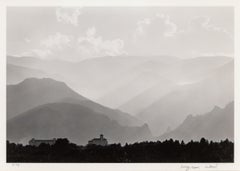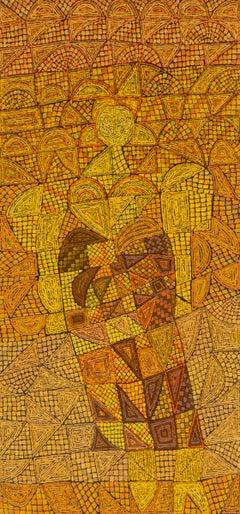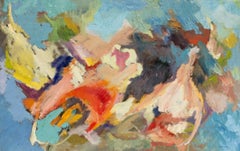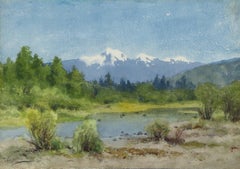
Established in 19791stDibs seller since 2013
Featured Pieces
Broadmoor and Front Range (Colorado), 1970s Black and White Mountain Landscape
By Myron Wood
Located in Denver, CO
Renowned Colorado photographer Myron Wood (1921–1999) was known for his poetic black and white images of the American Southwest. Based in Colorado Springs, Wood spent decades documen...
Category
1970s American Modern Black and White Photography
Materials
Photographic Film
"The Gold Witch" – Colorado Modernist Semi-Abstract Oil by Edward Marecak
By Edward Marecak
Located in Denver, CO
“The Gold Witch” is a striking original semi-abstract oil painting by mid-20th century Denver artist Edward Marecak. The composition features an abstracted female figure, rendered in...
Category
1980s Folk Art Figurative Paintings
Materials
Oil
Colorful Abstract Expressionist Oil by Florence V. Mercolino Graziano
By Florence Graziano
Located in Denver, CO
This original abstract oil painting by female artist Florence V. Mercolino Graziano is a vibrant and expressive composition full of color and energy. The work features dynamic brushw...
Category
Mid-20th Century Abstract Expressionist Abstract Paintings
Materials
Oil
Colorado Mountain Landscape with River, 1890s Watercolor Painting
By Charles Partridge Adams
Located in Denver, CO
This original late 19th-century watercolor painting beautifully captures a classic Colorado mountain landscape by iconic early 20th century artist, Charles Partridge Adams. The compo...
Category
1980s American Impressionist Landscape Paintings
Materials
Watercolor
"El Niño" Retablo – New Mexico-Style Contemporary Spanish Colonial Painting
Located in Denver, CO
This original retablo painting, titled "El Niño", is a striking contemporary work by Colorado-based artist Michael Blatnik. Inspired by the devotional traditions of Spanish Colonial ...
Category
21st Century and Contemporary Folk Art Figurative Paintings
Materials
Oil
“Ranchos de Taos Church Moonlight” 1950 Lithograph by Kenneth Miller Adams
By Kenneth Miller Adams
Located in Denver, CO
This captivating 1950 lithograph by renowned New Mexico artist Kenneth Miller Adams beautifully captures the iconic Ranchos de Taos Church bathed in serene moonlight. A celebrated su...
Category
1950s American Modern Still-life Prints
Materials
Lithograph
“Clowns, Jugglers and Acrobats” by Edward Marecak, 1986 Abstract Circus Art
By Edward Marecak
Located in Denver, CO
Bursting with color and kinetic energy, “Clowns, Jugglers and Acrobats” is a dynamic 1986 original painting by celebrated Colorado modernist Edward Marecak. Known for his bold visual...
Category
1980s Abstract Expressionist Figurative Paintings
Materials
Oil
“New Mexico” Adobe Painting by Pawel Kontny, 20th C. Southwestern Watercolor
By Pawel Kontny
Located in Denver, CO
This evocative 20th-century watercolor painting by Polish-American artist Pawel Kontny captures the timeless architecture and spirit of the Southwest. Titled “New Mexico,” the work f...
Category
Mid-20th Century Post-Modern Still-life Paintings
Materials
Watercolor
20th Century Black & White Photograph, Abandoned Victorian House
Located in Denver, CO
Atmospheric 20th-century black and white photograph by American photographer Harold E. Malde (1923–2007), featuring an abandoned Victorian-style house shrouded in wild, overgrown veg...
Category
20th Century American Modern Black and White Photography
Materials
Photographic Paper
1940s Ex Voto; Holy Tribute for the Return of Good Health, Retablo Painting
Located in Denver, CO
Ex Voto; Holy Tribute for the Return of Good Health. Oil on tin with ink, February 9, 1944, anonymous Mexican artist with a contemporary custom frame hand-carved by artisan Michael B...
Category
1940s Folk Art Figurative Paintings
Materials
Oil
Ex Voto; Miraculous Intervention of a Difficult Pregnacy, 19th Century Retablo
Located in Denver, CO
This authentic 19th-century Mexican ex-voto is a powerful testament to faith and survival, painted in oil on tin with ink circa 1869 by an anonymous Mexican artist. It is elegantly displayed in a custom, hand-carved frame enhancing its historical and artistic significance. The ex-voto itself measures 6 ½ x 9 ¾ inches, while the outer frame spans 14 ¼ x 17 ½ inches, making it a compelling piece for collectors of religious folk art.
A Miraculous Healing – A Story of Devotion
The heartfelt inscription tells the story of Mrs. Dia Anacleto Rodriguez, who, in 1860, faced a life-threatening childbirth with little hope of survival. In desperation, her husband, Mr. Epimenio Manzano, turned to Santo Niño de Atocha...
Category
1860s Folk Art Interior Paintings
Materials
Metal
The Phoenix – 1960s Mid-Century Abstract Art with Figures, Trees & Sun
By Edward Marecak
Located in Denver, CO
An original vintage 1960s semi-abstract painting by celebrated Colorado artist Edward Marecak, titled "The Phoenix." This dynamic composition bursts with expressive energy, rendered ...
Category
1960s Abstract Impressionist Abstract Paintings
Materials
Oil



